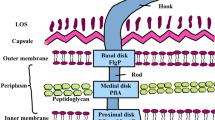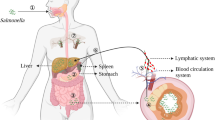Abstract
The aim of this study was to test the hypothesis that Bacillus subtilis antagonises enterotoxic Escherichia coli (ETEC) infection through mitogen-activated protein kinases (MAPK) signaling pathways. In vitro studies were performed in which ETEC-infected Caco-2 cultured human intestinal cells were first incubated with B. subtilis and then ETEC adhesion and MAPK activation were determined. Incubation with B. subtilis was found to reduce ETEC adhesion in Caco-2 cells by 58–72 % in the adhesive experiments (competition, exclusion, and displacement assays). ETEC was able to induce extracellular signal-regulated kinases 1 and 2 (ERK1/2) and p38 MAPK activation, but not c-Jun amino-terminal kinase (JNK) activation, in Caco-2 cells. ETEC-induced phosphorylation of ERK1/2, but not of p38, was inhibited significantly in ETEC-infected Caco-2 cells treated with B. subtilis. These findings suggest that B. subtilis is able to inhibit ETEC infection through blocking ETEC-induced ERK1/2 activation in Caco-2 cells. The data could provide a rationale for the clinical application of B. subtilis in enteric pathogenic infection.


Similar content being viewed by others
References
Arbibe L, Kim DW, Batsche E, Pedron T, Mateescu B, Muchardt C, Parsot C, Sansonetti PJ (2007) An injected bacterial effector targets chromatin access for transcription factor NF-kappa B to alter transcription of host genes involved in immune responses. Nat Immunol 8:47–56
Bhavsar AP, Guttman JA, Finlay BB (2007) Manipulation of host-cell pathways by bacterial pathogens. Nature 449:827–834
Czerucka D, Dahan S, Mograbi B, Rossi B, Rampal P (2001) Implication of mitogen-activated protein kinases in T84 cell responses to enteropathogenic Escherichia coli infection. Infect Immun 69:1298–1305
D’Arienzo R, Maurano F, Mazzarella G, Luongo D, Stefanile R, Ricca E, Rossi M (2006) Bacillus subtilis spores reduce susceptibility to Citrobacter rodentium-mediated enteropathy in a mouse model. Res Microbiol 157:891–897
Davis RJ (1993) The mitogen-activated protein-kinase signal transduction pathway. J Biol Chem 268:14553–14556
Diard S, Moal VL-L, Toribio AL, Boum Y, Vigier F, Servin AL, Bouvet O (2009) Norepinephrine-dependently released Dr fimbriae of diffusely adhering Escherichia coli strain IH11128 promotes a mitogen-activated protein kinase ERK1/2-dependent production of pro-inflammatory cytokine, IL-8 in human intestinal Caco-2/TC7 cells. Microbes Infect 11:886–894
Fairbrother JM, Nadeau E, Gyles CL (2005) Escherichia coli in postweaning diarrhea in pigs: an update on bacterial types, pathogenesis, and prevention strategies. Anim Health Res Rev 6:17–39
Galan JE, Bliska JB (1996) Cross-talk between bacterial pathogens and their host cells. Annu Rev Cell Dev Biol 12:221–255
Howe AK, Aplin AE, Juliano RL (2002) Anchorage-dependent ERK signaling-mechanism and consequences. Curr Opin Genet Dev 12:30–35
Huang DB, Mohanty A, DuPont HL, Okhuysen PC, Chiang T (2006) A review of an emerging enteric pathogen: enteroaggregative Escherichia coli. J Med Microbiol 55:1303–1311
Khan MAS, Kang J, Steiner TS (2004) Enteroaggregative Escherichia coli flagellin-induced interleukin-8 secretion requires Toll-like receptor 5-dependent p38 MAP kinase activation. Immunology 112:651–660
Kramer RW, Slagowski NL, Eze NA, Giddings KS, Morrison MF, Siggers KA, Starnbach MN, Lesser CF (2007) Yeast functional genomic screens lead to identification of a role for a bacterial effector in innate immunity regulation. PLoS Pathog 3:179–190
La Ragione RM, Woodward MJ (2003) Competitive exclusion by Bacillus subtilis spores of Salmonella enterica serotype Enteritidis and Clostridium perfringens in young chickens. Vet Microbiol 94:245–256
La Ragione RM, Casula G, Cutting SM, Woodward MJ (2001) Bacillus subtilis spores competitively exclude Escherichia coli O78: K80 in poultry. Vet Microbiol 79:133–142
Laferriere J, Houle F, Huot J (2002) Regulation of the metastatic process by E-selectin and stress-activated protein kinase-2/p38. Ann N Y Acad Sci 973:562–572
Maa SH, Wang CH, Liu CY, Lin HC, Huang KH, Kuo HP (2003) Endogenous nitric oxide downregulates the Bcl-2 expression of eosinophils through mitogen-activated protein kinase in bronchial asthma. J Allergy Clin Immun 112:761–767
Mukherjee S, Keitany G, Li Y, Wang Y, Ball HL, Goldsmith EJ, Orth K (2006) Yersinia YopJ acetylates and inhibits kinase activation by blocking phosphorylation. Science 312:1211–1214
Nagy B, Fekete PZ (2005) Enterotoxigenic Escherichia coli in veterinary medicine. Int J Med Microbiol 295:443–454
Nebreda AR, Porras A (2000) p38 MAP kinases: beyond the stress response. Trends Biochem Sci 25:257–260
Stupack DG, Cho SY, Klemke RL (2000) Molecular signaling mechanisms of cell migration and invasion. Immunol Res 21:83–88
Telenti A, Philipp WJ, Sreevatsan S, Bernasconi C, Stockbauer KE, Wieles B, Musser JM, Jacobs WR (1997) The emb operon, a gene cluster of Mycobacterium tuberculosis involved in resistance to ethambutol. Nat Med 3:567–570
Wang Y, Zhang J, Yi XJ, Yu FSX (2004) Activation of ERK1/2 MAP kinase pathway induces tight junction disruption in human corneal epithelial cells. Exp Eye Res 78:125–136
Zanello G, Berri M, Dupont J, Sizaret PY, D’Inca R, Salmon H, Meurens F (2011) Saccharomyces cerevisiae modulates immune gene expressions and inhibits ETEC-mediated ERK1/2 and p38 signaling pathways in intestinal epithelial cells. PLoS One 6:e18573
Acknowledgements
This work was supported by grants no. 30871858 from the National Science Grant of China and no. BE200830155 from the support programme of Jiangsu province.
Author information
Authors and Affiliations
Corresponding author
Electronic Supplementary Materials
Below is the link to the electronic supplementary material.
Supplementary Fig. S1
Activation of extracellular signal-regulated kinases (ERK1/2) by ETEC is regulated at different time points. Caco-2 cells were infected with ETEC for the times indicated. Cell lysates were prepared at each time point and analysed by Western blotting for the presence of phosphorylated ERK (p-ERK). The blots were then stripped and probed again with antibodies for total ERK. The images were analysed using Quantity One software, and the mean density of each band was measured. The density of the phosphorylated ERK band was divided by the density of the corresponding total ERK band to obtain the normalised band density, which is indicated below each lane. The results shown are representative of three separate experiments (the band densities presented refer specifically to the Western blots shown)
Rights and permissions
About this article
Cite this article
Ye, X., Li, P., Yu, Q. et al. Bacillus subtilis inhibition of enterotoxic Escherichia coli-induced activation of MAPK signaling pathways in Caco-2 cells. Ann Microbiol 63, 577–581 (2013). https://doi.org/10.1007/s13213-012-0506-8
Received:
Accepted:
Published:
Issue Date:
DOI: https://doi.org/10.1007/s13213-012-0506-8




